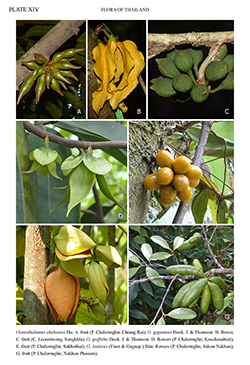e-Flora of Thailand
Volume 16 > Part 1 > Year 2022 > Page 122 > Annonaceae > Goniothalamus
2. Goniothalamus calvicarpus Craibwfo-0000706443
Bull. Misc. Inform. Kew 1922: 227. 1922; Craib, Fl. Siam. 1: 50. 1925; Yang et al., PhytoKeys 138: 21. 2020. Plate: XIII: F–G.
Accepted Name : This is currently accepted.
Synonyms & Citations :
Description : Treelet to 5 m tall. Young branches subglabrous to sparsely hairy. Leaves (sub)coriaceous, elliptic to obovate, 17.5–27(–30.5) by 4.5–7.5 cm, matt or glossy above, glabrous to very sparsely hairy below and above, secondary veins 13–19 pairs, prominent above; tertiary venation reticulate, highly distinct; petioles 7.5–13.5 mm long. Flowers solitary, on young growth, pedicels 8–12(–19) mm long. Sepals 11–18.5 by 8–15.5 mm, not reflexed, venation distinct. Outer petals yellow, 21–46 by 4.5–18 mm, (very sparsely) hairy abaxially, subglabrous to sparsely hairy adaxially with velutinous basal region facing apertures between inner petals, venation sometimes distinct. Inner petals greenish yellow, 12–20 by 2.5–5.5 mm, (sparsely) hairy abaxially, velutinous adaxially. Stamens 95–120, anther connective apex long-apiculate. Carpels 15–35, ovaries glabrous to (sparsely) hairy in lines; stigmas subulate, glabrous. Fruits with persistent sepals, pedicels ca 11 mm long. Monocarps red, ellipsoid, 1–1.4 by 0.7–0.8 cm, smooth, (sub)glabrous, stipe 2–4.5 mm long. Seeds solitary, 10.5–12 by 6.5–8 mm, slightly rugose, glabrous.
Thailand : NORTHERN: Chiang Mai, Chiang Rai, Nan, Lampang, Sukhothai (Khao Luang – type: Kerr 5946, holotype -K, isotypes -ABD BK K).
Distribution : China, Laos.
Ecology : Evergreen or deciduous forests, often growing by streams, (250–)600–850(–1,250) m alt. Flowering: March–September; fruiting: October–February.
Vernacular : Saban nga pa (สะบันงาป่า)(Chiang Mai).
Notes: Most herbarium collections of this species have been determined as Goniothalamus griffithii (Saunders & Chalermglin, Bot. J. Linn. Soc. 156: 355–384. 2008). Goniothalamus calvicarpus and G. griffithii also resemble G. tortilipetalus; see additional comments under that species.


